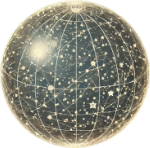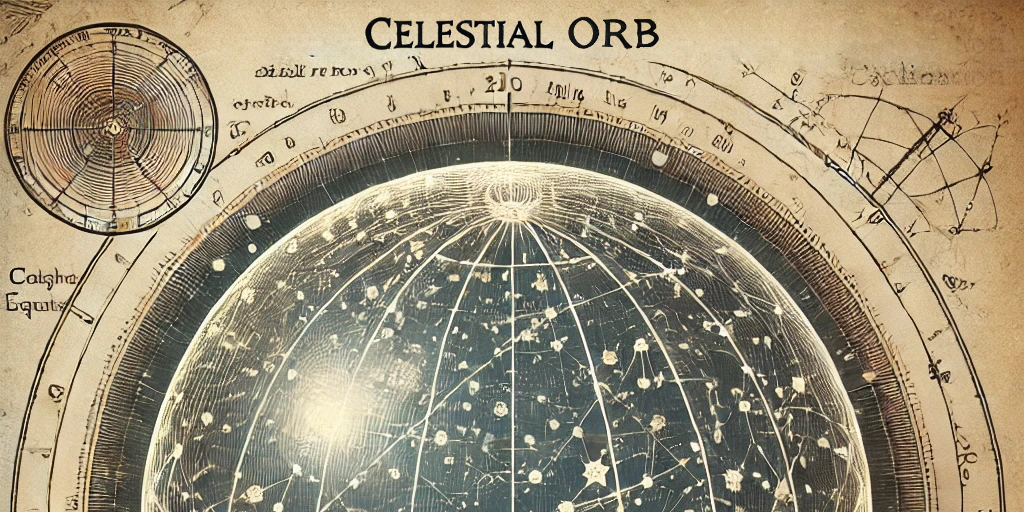 RA, Dec and the Celestial Sphere RA, Dec and the Celestial Sphere |  | Sooner or later as a stargazer, you will come across the terms RA and Dec. These are short for right ascension and declination and they’re used to find stars and other celestial bodies. But what are they and how do they work? It starts with the celestial sphere.
Celestial Sphere
Long ago, our ancestors imagined that Earth was at the center of a giant sphere that had a solid surface embedded with stars. They believed that it rotated around the Earth.
Of course no such sphere exists and it is the Earth that rotates amidst the stars. But the idea of a rotating celestial sphere was so clever that it is used today for mapping the night sky. The mapping system is known as the equatorial coordinate system.
Celestial Equator
At the center of the equatorial system is the celestial equator, a projection onto the sky of Earth’s equator. If we could see the celestial equator, it would appear as an arc stretching from the eastern to western horizon. It would appear high at Earth's equator, lower away from the equator, and very low at the poles, circling the horizon.
 |
To find the altitude of the celestial equator above your horizon, subtract your latitude from 90. So if your latitude is 47°N, the altitude of the celestial equator is 43° above your southern horizon, nearly halfway to the zenith.
|
North and South Celestial Poles
Just as the celestial equator is a projection of Earth’s equator onto the sky, the north and south celestial poles are projections of Earth’s poles onto the sky. These are abbreviated NCP and SCP. The star Polaris is within 1° of the NCP and makes it easy to find north. That’s why it's also called the North Star. The SCP does not have a nearby bright star and is a bit difficult to locate in the night sky.
 |
The altitude of the NCP or SCP at your location is the same as your latitude. So if your latitude is 47°N, the pole will be 47° above the northern horizon. The stars between the northern horizon and the pole will all be circumpolar, appearing to circle the pole without ever setting.
|
Declination
Just as Earth’s equator is at 0° latitude, the celestial equator is at 0° declination. Declination works just like latitude except that we use + and - instead of north and south. So the NCP is at +90° and the SCP is at -90°. Polaris is at +89.4°. Sirius, the brightest star in our night sky, is south of the celestial equator at -16.8°. Vega, the brightest star north of the celestial equator, is at +39.8°.
 |
Declinations range from +90° to -90°. Since it is 180° from horizon to horizon, you should be able to see all declinations, right? Yes, but only if you are at the equator. Otherwise, the range gets clipped by the circumpolar area. So, if you are at 47°N, you can see declinations from +90° to -43°. The highest 47° of declinations will be circumpolar, and the lowest 47° of declinations will never rise above your southern horizon.
|
Right Ascension
Similar to how longitude is used to map the east or west position on Earth, right ascension is used to map celestial objects in an east or west position on the celestial sphere. But, instead of degrees, time is used from 0 to 24 hours. You can see this in the diagram above.
Why time? It has to do with the meridian, the imaginary line that stretches overhead from the northern to southern horizons. It's important for stargazing because celestial objects are always highest in the sky when they cross the meridian.
RA is the time that a celestial object crosses the meridian. The right ascension of Sirius is 6h 46m 17s. It will cross your meridian at this time.
You may be wondering how this makes sense… how can Sirius cross everyone’s meridian at the same time? It’s possible if each location has its own special clock for the celestial sphere. This leads us to local sidereal time.
Local Sidereal Time
There are actually two kinds of time that apply to stargazing: solar time and sidereal time. Everyone already knows solar time because it is what we display on our clocks and watches. Solar time is based on the position of the Sun in our sky and is set up so that the Sun crosses the meridian close to noon. Time zones are used to adjust solar time so that this works all over Earth.
Sidereal time is based on the position of the stars in our sky. Because Earth orbits the Sun, the Sun appears to move 1° each day through the stars on a path called the ecliptic (see above). This causes a 4-minutes-per-day difference between solar and sidereal time. For more details on this, see How long is a Day?.
Key idea: to keep the stars aligned with the meridian at any longitude, we adjust sidereal time, not with time zones, but by calculating a local sidereal time, or LST. Every longitude has its own LST.
Putting it all Together
Imagine that you are on Earth looking up into the night sky. You are surrounded by a rotating sphere. Above your horizon you see an arc separating the two halves of the sphere, the celestial equator. You see one pole of the axis of rotation above the opposite horizon. You see stars, the Moon, Sun, and more, each mapped to the sphere using coordinates of right ascension and declination.
The whole sphere rotates via sidereal time. But the Sun, due to its brightness and slow travel around the sphere, gets its own version of time, solar time.
This describes the celestial sphere and its equatorial coordinate system. As wrong as this model is, it is quite useful in helping stargazers understand the sky above.
Some great news is that modern stargazing apps automatically handle the complexities of this model. They can display maps of the sky for any location and time with huge amounts of info. Right ascensions and declinations even get automatically updated due to precession, Earth’s 26,000 year wobble as a rotating sphere. Stargazing has never been so easy!
Over time, stargazers build these maps in their heads. The night sky becomes a familiar and friendly place and the daily and seasonal movements of the stars become anticipated and welcomed. In the poem The Old Astronomer to his Pupil by Sarah Williams, there is a line that conveys a sentiment that experienced stargazers understand well:
|
‟I have loved the stars too fondly to be fearful of the night”
|
Clear skies!
| |
|
|



